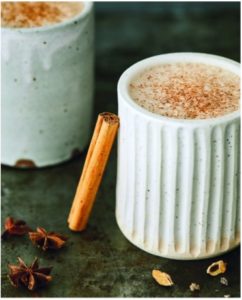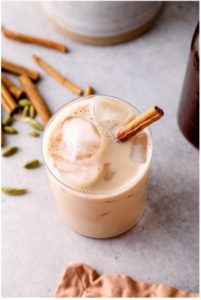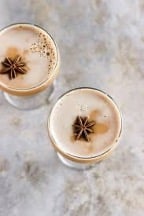
Chai tea: the Indian history of a spicy drink
Chai tea: the Indian history of a spicy drink
A spicy drink that usually marks the arrival of shorter days, Chai tea has in addition to its singular flavors, unsuspected benefits!
Highly appreciated for its taste qualities and recognized for its virtues, the Chai tea is enjoying growing success. With the arrival of autumn, what could be more comforting than this delicious spicy tea to warm up and face the cold with serenity?
The history of Chai tea:
- Chai is a hot drink originating in India. Originally, the dull Hindi “chai” is a derivative of the Mandarin “cha”, and refers to the “tea” in the Indian subcontinent in South Asia. Thus, talking about “chai tea” is therefore a pleonasm. In general, the chai often refers to “masala chai”, a sweet black tea with a mixture of spices and warm milk.
- The history of this recipe dates back more than 5,000 years. Originally, chai was initially used as an herbal remedy in traditional Hindu medicine “Ayurveda”. Moreover, at that time, the drink was composed only of milk, herbs and spices. It was not until the appearance of tea in Asia that it began to be added.
- It was in the nineteenth century, with the colonization by the British, that tea production was introduced in India with the construction of tea gardens. In a few years, the winery gained popularity throughout Great Britain. He then won a great success with the Indians.
Today, an Indian national drink, chai is enjoyed all over the world, tasting it both hot and cold.
The benefits of Chai tea:
The chai is a drink with recognized benefits, thanks to the wide variety of spices and plants it contains. Each ingredient has unique properties for a subtle marriage at the service of well-being.
Black tea:
With a long fermentation of tea leaves, black tea is concentrated in Theaflavins and Thearubigins, antioxidants from the polyphenol family. Antioxidants fight against free radicals in our body and thus protect our body against cellular aging.
Star anise (Badiane):
This Chinese spice used for its aniseed taste has anti-inflammatory, antiviral and carminative properties.
Cardamom:
Widely used in oriental medicine, it helps to facilitate digestion and soothes stomach upset after a large meal for example.
Cinnamon:
Known for its antioxidant properties and action against diabetes, cinnamon helps regulate blood glucose levels, control cholesterol levels, and reduce blood pressure. It is also energizing.
Fennel:
A true ally to limit digestive disorders and inflammation of the respiratory tract, this plant is an excellent source of antioxidants, vitamin C and fiber.
Ginger:
This rhizome has antioxidant and anti-inflammatory properties. Its active ingredients help to improve intestinal transit, circulation and stimulate the immune system.
Black pepper:
Highly appreciated for its antibacterial properties, the black pear supports the metabolism and thus helps to fight against the storage of fat in the body.
The preparation of chai latte
First of all, there is no fixed recipe for Chai latte. Everyone adapts it according to their preferences! Traditionally, the chai is often rather sweet to enhance the taste of certain spices, so do not hesitate to have fun if you like spicy mixtures.
Essential ingredients:
- 2 spoons of your spice and tea blend
- 1L of water
- 1 teaspoon honey or agave syrup
- 10cl cow’s milk, almond or oats
- 1 pinch of cinnamon
Step 1: brew the spicy tea
Boil your water and pour it up to a third of your cup to brew the tea. Let it infuse more or less long according to your taste.
- Our recommendation: infused between 2 to 3 minutes for a balance of flavors.
Step 2: heat and froth the milk
Put the milk in a saucepan over low heat to heat the milk without burning it.
You can then have fun frothing your milk!
- Our recommendation: used a milk frother, utensil sold commercially.
Step 3: pour the milk
In the cup containing the tea, add the milk as you go until you almost fill it.
- Our recommendation: pour by tilting the cup to run the milk to the bottom and keep the milk foam in the pan.
Step 4: compose your cup
Pour the preparation into the strainer in order to separate the tea and spices from the drink, pour into the cup. Add the milk foam on top.
- Our recommendation: add powdered cinnamon on top for more color.
For a refreshing version:
You can add cold milk this time to your spice preparation, as well as some ice cubes…
Shake it all and hop, an iced chai latte!
Dirty chai latte
If your heart swings between coffee and chai latte, thanks to this recipe useless to choose!
What is it?
Dirty chai latte is a drink that originated in England in the 1,990s. A barista would have wanted to make a joke to a friend by adding an espresso to his cellar. But far from displeasing him, the customer took it back from him every morning and that everywhere he traveled.
This drink is an excellent compromise between tea and coffee because it allows you to drink a coffee even if you do not like it. The coffee is there to complement the subtle and creamy sweetness of the cellar.
Due to its double dose of black tea and espresso, it’s a tasty energy booster!
The preparation of dirty chai latte:
- You will need for this recipe the same ingredients as for the classic chai latte.
- On the other hand, you will need an espresso (or a double for even more energy).
- Our recommendation: the oat drink for even more taste and lightness!
Happy tasting!
Discover our histoty : https://delasierracafe.com/shop/abous-us/
Facebook : https://www.facebook.com/delasierracafe
Instagram : https://www.instagram.com/delasierracafe/?hl=en
Sources : csa.coffee / perfetcdailygrind.com





